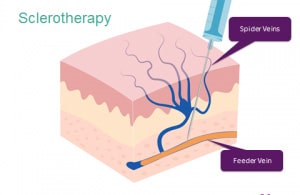Introduction
At Precision, sclerotherapy is a minimally invasive treatment of common spider and small varicose veins without the need of anesthesia performed in the office . It is can used to treat spider veins visible at the surface of the skin. It also applies to treatment of veins that are deeper under the skin surface, which is aided with the use of ultrasound guidance. Sclerotherapy involves the injection of a chemical sclerosant directly into the diseased vein, causing a local irritation and ultimately causes the vein to close. The solution can be in a liquid or foam.
The sclerosant we use at Precision is the safest and most effective on the market.
A tiny needle is inserted into the spider or varicose vein and the sclerosant is injected causing irreversible injury to the blood vessel. After injection, the chemical solution causes irritation of the vein wall causing it to spasm. Clotting of the vessel ensues and the body’s natural inflammatory response takes over with eventual reabsorbing of the vessel over time leading to its disappearance. The clots within the spider vein do not move or travel via the circulation and therefore are essentially of no health concern. In rare cases when the blood clots do not resorb, a tiny procedure at follow-up can be performed to remove them. Most spider veins begin to fade within 2 to 3 weeks and most are totally gone by 4 to 6 weeks. Larger veins or ones of the foot or ankle may take considerably longer, up to 2 to 3 months or so, to resolve. Foam is also very safe as it quickly dilutes when it gets to the deeper venous circulation. It becomes dilute and ineffective in the larger deeper and central veins. Foam sclerotherapy is a reasonable and safe treatment. When ablation of incompetent larger superficial veins is necessary and these cannot be treated with radiofrequency because of tortuous anatomy or other factors, then foam sclerotherapy is a great option. At Precision, we are adept at using foam sclerotherapy at treating difficult cases as well as using it as a powerful adjunctive tool in treating venous disease. After Sclerotherapy Compression stockings are used after sclerotherapy to aid healing and provide better results. Multiple sclerotherapy treatments are commonly necessary to eliminate all spider veins. Treatments usually occur 4 to 6 weeks apart, but can vary based on each patient. Also read more on instructions after sclerotherapy. The outcome of sclerotherapy is dependent on the type of sclerosant used, patient compliance as well as the skill and experience of the individual performing the treatment. Results will vary from patient to patient. Treatment failures require added scrutiny to determine if other problems are present causing the veins to resist closure. This can be due to increased pressures from reflux in larger superficial or deep veins of the leg. These problems are usually detected before the treatment when one of our experienced physicians at Precision initially examines the patient. A short ultrasound study is performed as part of the initial examination to determine if certain conditions exist such as venous reflux that may predispose sclerotherapy to failure or the results to be suboptimal. If these are present, they will be addressed at the initial consultation and a treatment plan will be discussed to achieve optimum results.
The outcome of sclerotherapy is dependent on the type of sclerosant used, patient compliance as well as the skill and experience of the individual performing the treatment. Results will vary from patient to patient. Treatment failures require added scrutiny to determine if other problems are present causing the veins to resist closure. This can be due to increased pressures from reflux in larger superficial or deep veins of the leg. These problems are usually detected before the treatment when one of our experienced physicians at Precision initially examines the patient. A short ultrasound study is performed as part of the initial examination to determine if certain conditions exist such as venous reflux that may predispose sclerotherapy to failure or the results to be suboptimal. If these are present, they will be addressed at the initial consultation and a treatment plan will be discussed to achieve optimum results. Visual sclerotherapy is generally used to treat small, red or blue spider veins and reticular veins. It involves directly injecting the sclerosant into the vein using a very small needle. The amount and concentration of solution injected depend on the size and extent of the spider veins. The goal is to cause damage to the visible veins, without damaging surrounding structures. Often, one can visually see the spider veins closing off and disappearing instantly.
Visual sclerotherapy is generally used to treat small, red or blue spider veins and reticular veins. It involves directly injecting the sclerosant into the vein using a very small needle. The amount and concentration of solution injected depend on the size and extent of the spider veins. The goal is to cause damage to the visible veins, without damaging surrounding structures. Often, one can visually see the spider veins closing off and disappearing instantly. Ultrasound-guided sclerotherapy can be used to treat deeper veins that are underneath the skin at various depths. These are sometimes referred to as tributary or perforator veins. Often ultrasound guided sclerotherapy is used as an adjunctive therapy to treat the veins that feed abnormal varicose or spider veins. Ultrasound guided foam sclerotherapy may be used as the foam has been proven to increase the strength of the treatment. In severe cases, the perforator veins could be the cause of a venous ulcer. Precision doctors are experts at using ultrasound to guide the needle and medication into its desired location.
Ultrasound-guided sclerotherapy can be used to treat deeper veins that are underneath the skin at various depths. These are sometimes referred to as tributary or perforator veins. Often ultrasound guided sclerotherapy is used as an adjunctive therapy to treat the veins that feed abnormal varicose or spider veins. Ultrasound guided foam sclerotherapy may be used as the foam has been proven to increase the strength of the treatment. In severe cases, the perforator veins could be the cause of a venous ulcer. Precision doctors are experts at using ultrasound to guide the needle and medication into its desired location. At Precision sclerotherapy using polidocanol made into a foam is sometimes used. The advantage of foam is the foam tends to cling to the inside lining of the vein which allows more time for the medication to injure the vein walls. Liquid tends to be washed out more rapidly with less time for the medication to contact the walls and cause sclerosis. The foam is particularly effective for larger veins as the volume and brisk flow of blood washes the liquid away much quicker making for less effective treatment. Foam clings to the walls of the veins avoiding the washing away effect that liquid is subject to.
At Precision sclerotherapy using polidocanol made into a foam is sometimes used. The advantage of foam is the foam tends to cling to the inside lining of the vein which allows more time for the medication to injure the vein walls. Liquid tends to be washed out more rapidly with less time for the medication to contact the walls and cause sclerosis. The foam is particularly effective for larger veins as the volume and brisk flow of blood washes the liquid away much quicker making for less effective treatment. Foam clings to the walls of the veins avoiding the washing away effect that liquid is subject to.

